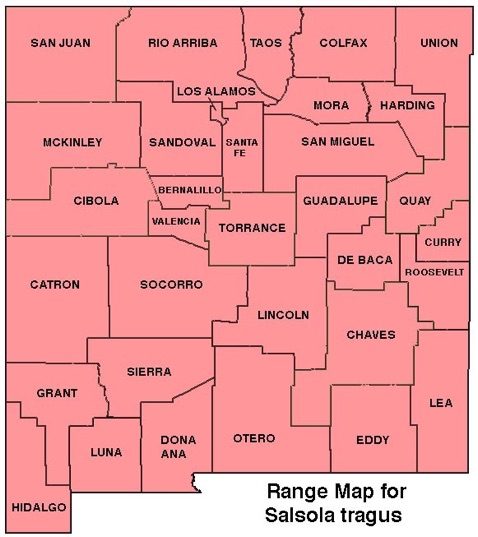WILDFLOWERS OF NEW MEXICO

This noxious alien from Europe, first documented in the U. S. in 1870, found heaven on Earth in the overgrazed, abused pastures and prairies of the West. It quickly spread a prickly blanket across countless acres of degraded range and farmland. In the winter, the dried “bushes” can reach 3 feet across and accumulate in huge, wind-blown, prickly piles on the windward side of fences, gullies, and buildings. Note the rounded shape from the dense, interlocking branches, the reddish stripes on fresh stems, and the tiny dish-like pinkish flowers in the leaf axils.
FLOWER: July–October. Solitary in upper leaf axils, 3 spiny green bracts spread beneath 5 pinkish petal-like sepals, each oval, 1/8 inch long (3 mm); no petals.
LEAVES: Alternate. Blades threadlike, 3/8–2 inches long (1–5 cm), becoming rigid, spine-tipped.
HABITAT: Dry sandy, disturbed soils; roadsides, abandoned farms, range lands.
ELEVATION: 3,500–8,000 feet
RANGE: Widespread across the U. S.; in every state west of the Mississippi River.
SIMILAR SPECIES: The look-alikes Slender Russian Thistle, S. collina, and Barbwire Russian Thistle, S. paulsenii, share much of the range in NM and the Southwest.
NM COUNTIES: Widespread statewide in low- to mid-elevation, dry habitats.

TUMBLEWEED, RUSSIAN THISTLE
SALSOLA TRAGUS (SALSOLA KALI)
Pigweed Family, Amaranthaceae (formerly Chenopodiaceae)
Annual subshrub; introduced, invasive



THE CONTENTS OF THIS WEBSITE ARE COPYRIGHTED AND CANNOT BE USED
WITHOUT PERMISSION OF GEORGE OXFORD MILLER
EMAIL ME

• Fresh stems are often red striped.
• Petal-like sepals are pinkish-green (right arrow).
• Spine-tipped bracts are beneath the flower (left arrow)


